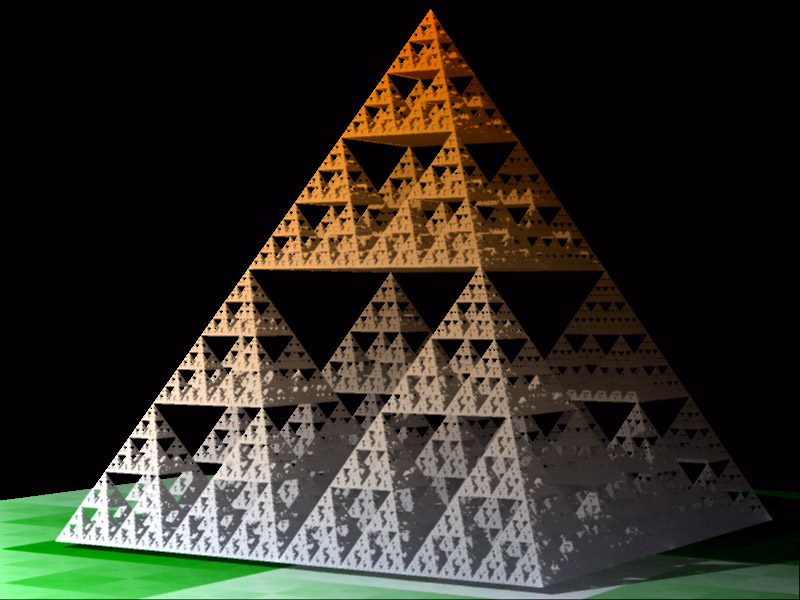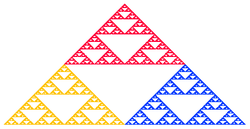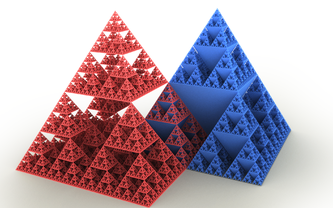The Sierpinski triangle (also with the original orthography Sierpiński), also called the Sierpinski gasket or the Sierpinski Sieve, is a fractal and attractive fixed set named after the Polish mathematician Wacław Sierpiński who described it in 1915. However, similar patterns appear already in the 13th-century Cosmati mosaics in the cathedral of Anagni, Italy.[1] and other places, such as in the nave of the Roman Basilica of Santa Maria in Cosmedin.
Originally constructed as a curve, this is one of the basic examples of self-similar sets, i.e. it is a mathematically generated pattern that can be reproducible at any magnification or reduction.
Comparing the Sierpinski triangle or the Sierpinski carpet to equivalent repetitive tiling arrangements, it is evident that similar structures can be built into any rep-tile arrangements.
Construction
An algorithm for obtaining arbitrarily close approximations to the Sierpinski triangle is as follows:Note: each removed triangle (a trema) is topologically an open set.[2]
- Start with any triangle in a plane (any closed, bounded region in the plane will actually work). The canonical Sierpinski triangle uses an equilateral triangle with a base parallel to the horizontal axis (first image).
- Shrink the triangle to ½ height and ½ width, make three copies, and position the three shrunken triangles so that each triangle touches the two other triangles at a corner (image 2). Note the emergence of the central hole - because the three shrunken triangles can between them cover only 3/4 of the area of the original. (Holes are an important feature of Sierpinski's triangle.)
- Repeat step 2 with each of the smaller triangles (image 3 and so on).
The actual fractal is what would be obtained after an infinite number of iterations. More formally, one describes it in terms of functions on closed sets of points. If we let
 note the dilation by a factor of ½ about a point a, then the Sierpinski
triangle with corners a, b, and c is the fixed set of the
transformation
note the dilation by a factor of ½ about a point a, then the Sierpinski
triangle with corners a, b, and c is the fixed set of the
transformation  U
U  U
U  .
.This is an attractive fixed set, so that when the operation is applied to any other set repeatedly, the images converge on the Sierpinski triangle. This is what is happening with the triangle above, but any other set would suffice.
If one takes a point and applies each of the transformations
 ,
,  , and
, and  to it randomly, the resulting points will be dense in the Sierpinski
triangle, so the following algorithm will again generate arbitrarily
close approximations to it:
to it randomly, the resulting points will be dense in the Sierpinski
triangle, so the following algorithm will again generate arbitrarily
close approximations to it:Start by labeling p1, p2 and p3 as the corners of the Sierpinski triangle, and a random point v1. Set vn+1 = ½ ( vn + prn ), where rn is a random number 1, 2 or 3. Draw the points v1 to v∞. If the first point v1 was a point on the Sierpiński triangle, then all the points vn lie on the Sierpinski triangle. If the first point v1 to lie within the perimeter of the triangle is not a point on the Sierpinski triangle, none of the points vn will lie on the Sierpinski triangle, however they will converge on the triangle. If v1 is outside the triangle, the only way vn will land on the actual triangle, is if vn is on what would be part of the triangle, if the triangle was infinitely large.
Or more simply:
- Take 3 points in a plane to form a triangle, you need not draw it.
- Randomly select any point inside the triangle and consider that your current position.
- Randomly select any one of the 3 vertex points.
- Move half the distance from your current position to the selected vertex.
- Plot the current position.
- Repeat from step 3.
Or using an Iterated function system
An alternative way of computing the Sierpinski triangle uses an Iterated function system and starts by a point at the origin (x0 = 0, y0 = 0). The new points are iteratively computed by randomly applying (with equal probability) one of the following three coordinate transformations (using the so called chaos game):
xn+1 = 0.5 xn
yn+1 = 0.5 yn; a half-size copy
This coordinate transformation is drawn in yellow in the figure.
xn+1 = 0.5 xn + 0.25
yn+1 = 0.5 yn + 0.5
 ; a half-size copy shifted right and up
; a half-size copy shifted right and upThis coordinate transformation is drawn using red color in the figure.
xn+1 = 0.5 xn + 0.5
yn+1 = 0.5 yn; a half-size copy doubled shifted to the right
When this coordinate transformation is used, the triangle is drawn in blue.
Or using an L-system — The Sierpinski triangle drawn using an L-system.
bitwise AND - The 2D AND function, z=AND(x,y) can also produce a white on black right angled Sierpinski triangle if all pixels of which z=0 are white, and all other values of z are black.
bitwise XOR - The values of the discrete, 2D XOR function, z=XOR(x,y) also exhibit structures related to the Sierpinski triangle. For example, one could generate the Sierpinski triangle by setting up a 2 dimensional matrix, [rows][columns] placing the uppermost point on [1][n/2], then cycling through the remaining cells row by row the value of the cell being XOR([i-1][j-1],[i-1][j+1])
Other means — The Sierpinski triangle also appears in certain cellular automata (such as Rule 90), including those relating to Conway's Game of Life. The automaton "12/1" when applied to a single cell will generate four approximations of the Sierpinski triangle.
If one takes Pascal's triangle with 2n rows and colors the even numbers white, and the odd numbers black, the result is an approximation to the Sierpinski triangle. More precisely, the limit as n approaches infinity of this parity-colored 2n-row Pascal triangle is the Sierpinski triangle.
Properties
The Sierpinski triangle has Hausdorff dimension log(3)/log(2) ≈ 1.585, which follows from the fact that it is a union of three copies of itself, each scaled by a factor of 1/2.The area of a Sierpinski triangle is zero (in Lebesgue measure). The area remaining after each iteration is clearly 3/4 of the area from the previous iteration, and an infinite number of iterations results in zero. Intuitively one can see this applies to any geometrical construction with an infinite number of iterations, each of which decreases the size by an amount proportional to a previous iteration.[citation needed]
Analogues in higher dimensions
The initial surface area of the (iteration-0) tetrahedron of side-length L is
 . At the next iteration, the side-length is halved
. At the next iteration, the side-length is halvedThe total enclosed volume, however, is geometrically decreasing (factor of 0.5) with each iteration and asymptotically approaches 0 as the number of iterations increases. In fact, it can be shown that, while having fixed area, it has no 3-dimensional character. The Hausdorff dimension of such a construction is
 which agrees with the finite area of the figure. (A Hausdorff dimension
strictly between 2 and 3 would indicate 0 volume and infinite area.)
which agrees with the finite area of the figure. (A Hausdorff dimension
strictly between 2 and 3 would indicate 0 volume and infinite area.)Trivia
In an interview with KCRW's Bookworm, David Foster Wallace stated that his novel Infinite Jest structurally resembles the Sierpinski triangle.[4]See also
- Apollonian gasket
- Chaos game
- List of fractals by Hausdorff dimension
- Pascal's triangle
- Rule 90
- Sierpinski carpet
- Sierpiński arrowhead curve
References
- ^ Wolfram, Stephen (2002), A New Kind of Science, Wolfram Media, pp. 43, 873
- ^ "Sierpinski Gasket by Trema Removal"
- ^ Michael Barnsley, et al."V-variable fractals and superfractals"PDF (2.22 MB)
- ^ http://www.kcrw.com/etc/programs/bw/bw081127david_foster_wallace

Sierpinski triangle in logic: The first 16 conjunctions of lexicographically ordered arguments
The columns interpreted as binary numbers give 1, 3, 5, 15, 17, 51... (sequence A001317 in OEIS)
The columns interpreted as binary numbers give 1, 3, 5, 15, 17, 51... (sequence A001317 in OEIS)










Aucun commentaire:
Enregistrer un commentaire
Remarque : Seul un membre de ce blog est autorisé à enregistrer un commentaire.